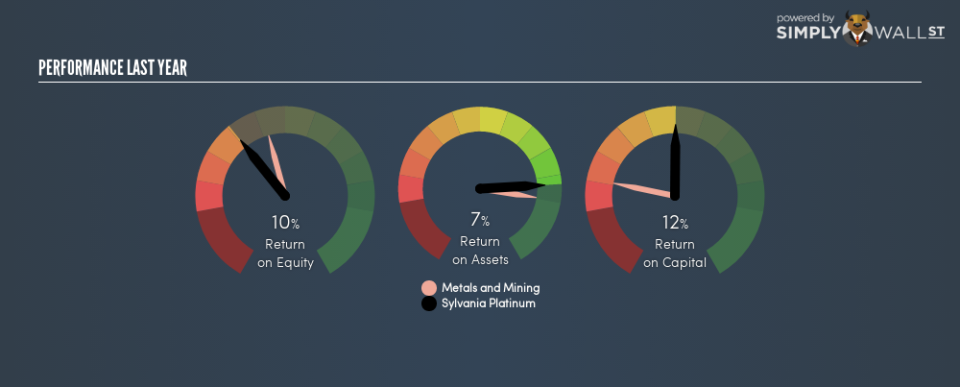Do You Know About Sylvania Platinum Limited’s (LON:SLP) ROCE?

Want to participate in a short research study? Help shape the future of investing tools and you could win a $250 gift card!
Today we are going to look at Sylvania Platinum Limited (LON:SLP) to see whether it might be an attractive investment prospect. Specifically, we’re going to calculate its Return On Capital Employed (ROCE), in the hopes of getting some insight into the business.
First of all, we’ll work out how to calculate ROCE. Second, we’ll look at its ROCE compared to similar companies. Last but not least, we’ll look at what impact its current liabilities have on its ROCE.
What is Return On Capital Employed (ROCE)?
ROCE measures the amount of pre-tax profits a company can generate from the capital employed in its business. In general, businesses with a higher ROCE are usually better quality. Ultimately, it is a useful but imperfect metric. Author Edwin Whiting says to be careful when comparing the ROCE of different businesses, since ‘No two businesses are exactly alike.’
So, How Do We Calculate ROCE?
Analysts use this formula to calculate return on capital employed:
Return on Capital Employed = Earnings Before Interest and Tax (EBIT) ÷ (Total Assets – Current Liabilities)
Or for Sylvania Platinum:
0.12 = US$16m ÷ (US$136m – US$5.8m) (Based on the trailing twelve months to June 2018.)
Therefore, Sylvania Platinum has an ROCE of 12%.
View our latest analysis for Sylvania Platinum
Does Sylvania Platinum Have A Good ROCE?
When making comparisons between similar businesses, investors may find ROCE useful. Using our data, Sylvania Platinum’s ROCE appears to be around the 13% average of the Metals and Mining industry. Independently of how Sylvania Platinum compares to its industry, its ROCE in absolute terms appears decent, and the company may be worthy of closer investigation.
In our analysis, Sylvania Platinum’s ROCE appears to be 12%, compared to 3 years ago, when its ROCE was 2.6%. This makes us think the business might be improving.
When considering ROCE, bear in mind that it reflects the past and does not necessarily predict the future. ROCE can be deceptive for cyclical businesses, as returns can look incredible in boom times, and terribly low in downturns. This is because ROCE only looks at one year, instead of considering returns across a whole cycle. Remember that most companies like Sylvania Platinum are cyclical businesses. Future performance is what matters, and you can see analyst predictions in our free report on analyst forecasts for the company.
Do Sylvania Platinum’s Current Liabilities Skew Its ROCE?
Short term (or current) liabilities, are things like supplier invoices, overdrafts, or tax bills that need to be paid within 12 months. Due to the way the ROCE equation works, having large bills due in the near term can make it look as though a company has less capital employed, and thus a higher ROCE than usual. To check the impact of this, we calculate if a company has high current liabilities relative to its total assets.
Sylvania Platinum has total liabilities of US$5.8m and total assets of US$136m. Therefore its current liabilities are equivalent to approximately 4.3% of its total assets. With low current liabilities, Sylvania Platinum’s decent ROCE looks that much more respectable.
Our Take On Sylvania Platinum’s ROCE
If Sylvania Platinum can continue reinvesting in its business, it could be an attractive prospect. You might be able to find a better buy than Sylvania Platinum. If you want a selection of possible winners, check out this free list of interesting companies that trade on a P/E below 20 (but have proven they can grow earnings).
I will like Sylvania Platinum better if I see some big insider buys. While we wait, check out this free list of growing companies with considerable, recent, insider buying.
To help readers see past the short term volatility of the financial market, we aim to bring you a long-term focused research analysis purely driven by fundamental data. Note that our analysis does not factor in the latest price-sensitive company announcements.
The author is an independent contributor and at the time of publication had no position in the stocks mentioned. For errors that warrant correction please contact the editor at editorial-team@simplywallst.com.

 Yahoo Finance
Yahoo Finance 
